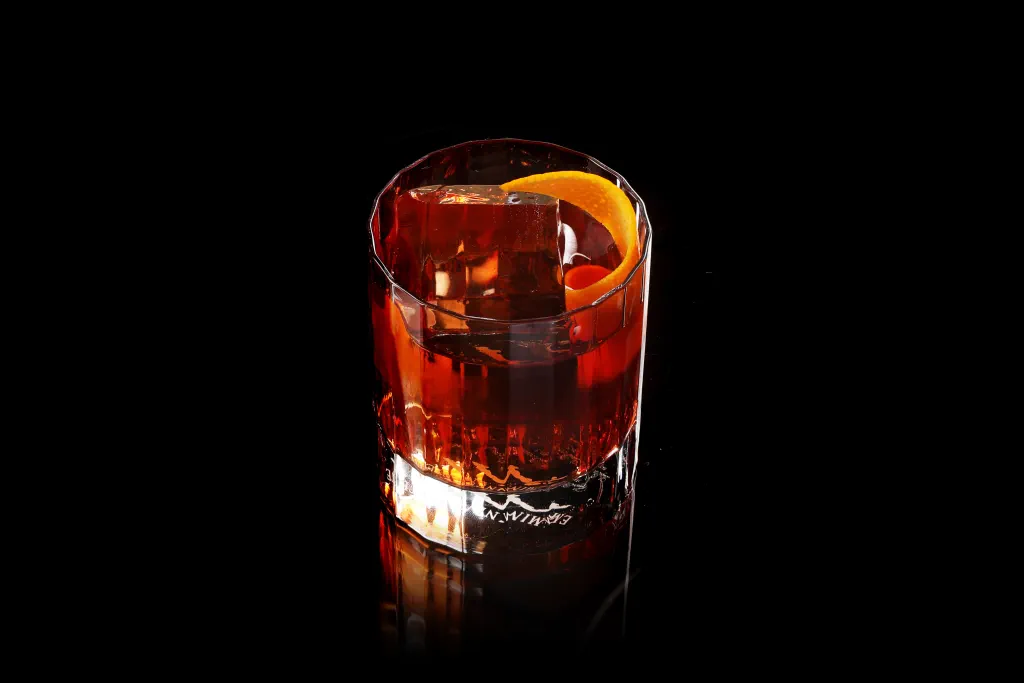Boulevardier Cocktail

Glass:
Serve in an Old-fashioned glass
| 1 1⁄2 oz | Bourbon whiskey |
| 3⁄4 oz | Strucchi Rosso Vermouth |
| 3⁄4 oz | Italian red bitter liqueur |
Prepare:
- Select and pre-chill an OLD-FASHIONED GLASS.
- Prepare garnish of orange zest twist.
How to make:
- STIR all ingredients with ice.
- STRAIN into ice-filled glass (preferably over a large cube or chunk of block ice).
Garnish:
- EXPRESS orange zest twist over the cocktail and use as garnish.
Allergens:
Recipe contains the following allergens:
- Rosso/rouge/sweet vermouth (di Torino) - Sulphur Dioxide/Sulphites
Strength & taste guide:

Review:
Basically, a Negroni with bourbon replacing gin. The original 1927 recipe calls for equal parts, but I've previously favoured a 3:2:2 (45ml bourbon, 30ml rosso vermouth, 30ml red bitter liqueur) recipe. Popular demand (see comments) has led me to adopt a 2:1:1 recipe, as I concede it's better balanced.
Variant:
Banana Boulevardier
Irish whiskey-based Boulevardier
Casa Savoia Boulevardier
Rye whisky-based Boulevardier
Left Hand
Right Hand (aged rum-based Boulevardier/Negroni)
History:
The Boulevardier first appears in Harry MacElhone's's 1927 Barflies and Cocktails. Not among the book's A-Z listing of recipes, but in a chapter titled "Cocktails Round Town", written by Arthur Moss, the "Around the Town" columnist of the New York Herald, Paris. Named and modelled after his newspaper column, Moss recounts cocktails created by or for other Harry's Bar regulars.
Moss was one of a group of wealthy American ex-pats and self-titled Boulevardiers, in reference to their crawling the boulevards between Harry's and other leading Parisian night haunts. Moss, along with two other writers and socialites from the group, Erskine Gwynne and Jeff Kiley, co-founded a magazine they called Boulevardier.
Moss had previously co-founded two other literary magazines, The Quill (1917) and Gargoyle (1921), the latter of which didn't survive a second year. However, The Quill, which focused on the artistic community in New York's Greenwich Village, had proved successful, particularly for Moss, as he married one of its editors, Florence Gilliam. The two moved to Paris in 1921.
The Boulevardier, published in Paris from 1927 to 1932, was modelled after The New Yorker and featured an impressive roster of contributors, including the likes of Noël Coward, Sinclair Lewis and Ernest Hemingway.
Among the cocktails Moss included in Harry's book was the Boulevardier, created by Erskine Gwynne, a nephew of railroad tycoon Alfred Vanderbilt. Crucially, Gwynne was, of course, one of the other cofounders of the Boulevardier magazine, which coincidently launched the same year Harry's book was published. Hence the cocktail's apt name.
Now is the time for all good Barflies to come to the aid of the party, since Erskinne Gwynne crashed in with his Boulevardier Cocktail: 1/3 Campari, 1/3 Italian vermouth, 1/3 Bourbon whisky.
Arthur Moss, Barflies and Cocktails, 1927
See: Negroni cocktail history and how the Boulevardier fits in
Nutrition:
One serving of Boulevardier Cocktail contains 200 calories
Alcohol content:
- 1.7 standard drinks
- 25.79% alc./vol. (51.57° proof)
- 23.2 grams of pure alcohol
- More Aperitivo/aperitif cocktails
- More Autumn/fall cocktails
- More Bittersweet (e.g. Negroni) cocktails
- More Classic/vintage cocktails
- More Hall of Fame & must know/try cocktails
- More Winter cocktails
Difford’s Guide remains free-to-use thanks to the support of the brands in green above. Values stated for alcohol and calorie content, and number of drinks an ingredient makes should be considered approximate.

Orange Negroni

Peroni Negroni

Negroni cocktail
James Bond drank a Negroni when he wasn't in the mood for a Martini, and when Orson Welles tried his first one in 1947, he commented, "The bitters are...
Liqueurs & cordials
Liqueurs and alcoholic cordials are sweetened alcoholic drinks made by mixing or redistilling spirits with flavourings and colourings. Within the EEC a...
Bourbon
Bourbon is as American as the Stars and Stripes, the Grand Canyon, and pumpkin pie, but there are some common misconceptions about what exactly bourbon...
Italian red bitter liqueurs
There are numerous Italian bright crimson-coloured bittersweet liqueurs, but Campari is the best-known internationally. Campari is on the drier side of...
20 best Halloween cocktails
All Hallows' Eve, the 31st of October, is spook night with bizarre costumes, trick-or-treat, pumpkin carving, apple bobbing and bonfires all the rage...




Join the discussion
Showing 10 of 35 comments for Boulevardier Cocktail.
See discussion in the Forum
I do prefer a 1:1:1 Negroni over this for Campari use, and I prefer a Manhattan over this for bourbon + vermouth use, but will still make these occasionally as variety is the spice of life.
I wonder if doing a Chocolate Negroni with bourbon instead of gin would make the bourbon + campari combo truly shine? We shall find out later this week!